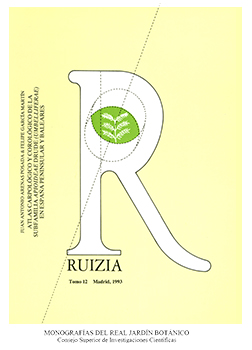
Subjects 
- Archaeology and Prehistory (161)
- Arts and Architecture (240)
- Earth Sciences (95)
- History and Historiography (302)
- History of Science (101)
- Information and Library Sciences (80)
- Life Sciences (170)
- Linguistics and Philology (100)
- Literature and Literary Criticism (133)
- Philosophy and Religion (110)
- Popular Science (257)
- Science and Technology (145)
- Social Sciences (152)
Collections 
Authors 
Send a friend 
Atlas carpológico y corológico de la subfamilia Apioideae Drude (Umbelliferae) en España peninsular y Baleares
  Juan Antonio Arenas Posada Affiliation: Not available Biography: Not available Felipe García Martín Affiliation: Not available Biography: Not available |
Juan Antonio Arenas Posada; Felipe García Martín Publication year: 1993 Language: Spanish Subjects: Life Sciences Collection: Ruizia. Monografías del Real Jardín Botánico Free eBook |
Abstract:
The introduction emphasizes historical aspects of umbelifer taxonomy and offers a brief phytogeographical sketch of Apioideae of Peninsular Spain and the Balearic Islands. The characters used in the study are then analyzed, paying special attention to those with greatest diagnostic value, such as the type of ridges, number of vitae, and the form of the endosperm in transverse section. The evolution of some of these characters is discussed, indicating the primitive and successive derived states. Description of fruits are preceded by keys. Four groups are recognized within the Apioideae according to: 1) the nature of the ridges (primary and/or secondary); 2) the development of the primary marginal ridges relative to dorsal ones; 3) the development of secondary ridges into wings, and 4) the elongation of secondary ridges into spines. After the description of the fruits of each taxon, date is presented concerning: 1) the phenology of the fructification; 2) the ecology, and 3) the general distribution of the taxon. The material used for the carpological study is indicated, and for each taxon a distribution map within the study área is given in an appendix. The maps were created utilizing both verified herbarium materials and biblio¬ graphic sources including classical Spanish Floras and Peninsular botanical journals.
Bibliographic information
Physical Description : 244 p. : il. ; 24 cm
ISBN: 978-84-00-07357-2
ISSN: 0212-9108
Publication: Madrid : Consejo Superior de Investigaciones Científicas, 1993
Reference CSIC: Ruizia_12
Buy the digital edition atThis eBook is available for free download Buy the print edition at |
Free Downloads |
This book was added to our online catalog on Monday 25 August, 2014.







